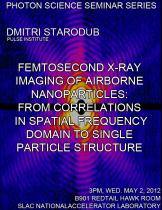Speaker: Dmitri Starodub, PULSE Institute
Program Description
Ultra-short and ultra-bright photon pulses from a free electron laser are able to provide diffractive imaging of randomly oriented and frozen in time identical particles in solution or vacuum. That allows use of correlation analysis which can yield expansion of the three-dimensional diffraction volume in spherical harmonics. We report the first application of this analysis with subsequent electron density reconstruction for the experimental data collected at the LCLS from unsupported particles in random and unknown orientations, with one particle per shot. The samples are created via aerosol self-assembly of two 91-nm polystyrene spheres into a dumbbell-shaped particle. Correlation analysis of scattered intensity gives information on the sample symmetry, eliminates requirement for orientation determination of each diffraction pattern, allows multiple particles in a single X-ray shot, and is robust to fluctuations of the incident X-ray flux and signal to noise level. This approach has a potential for structure determination of biological macromolecules in native environment.





